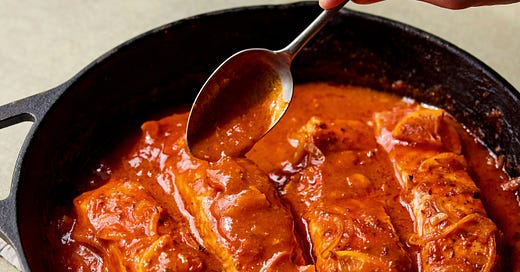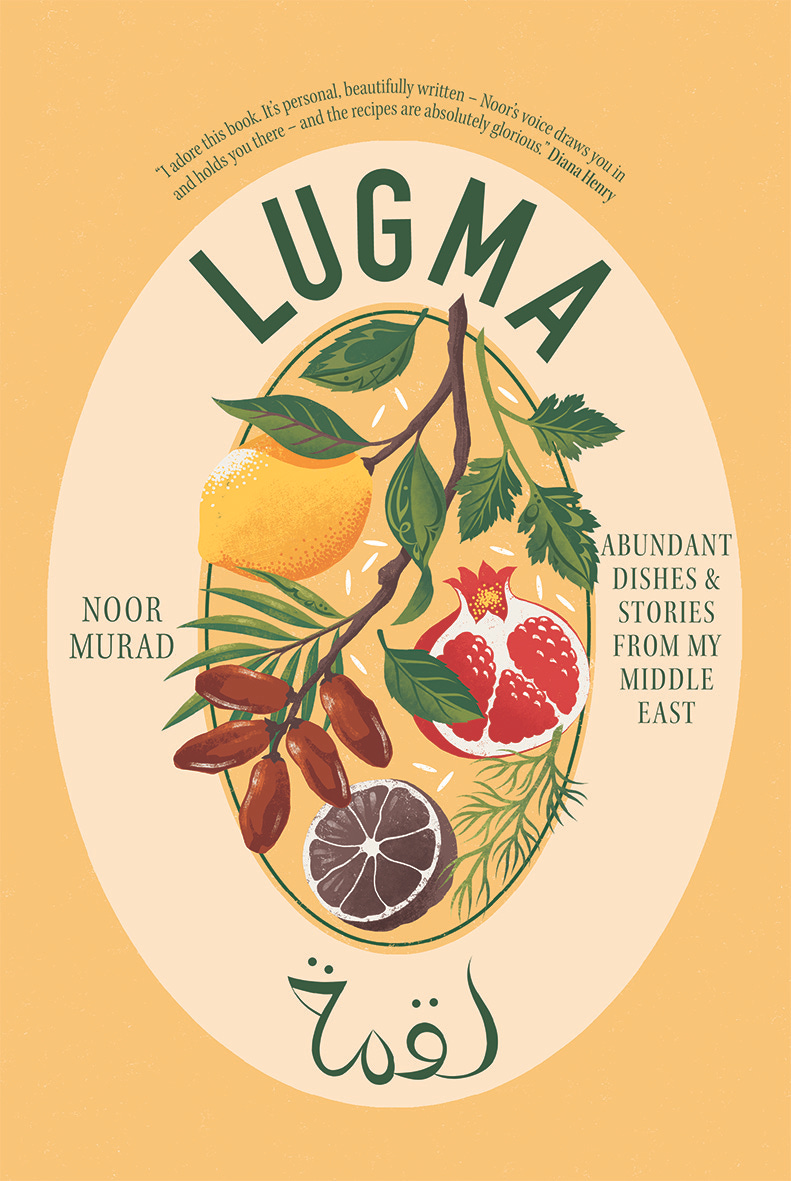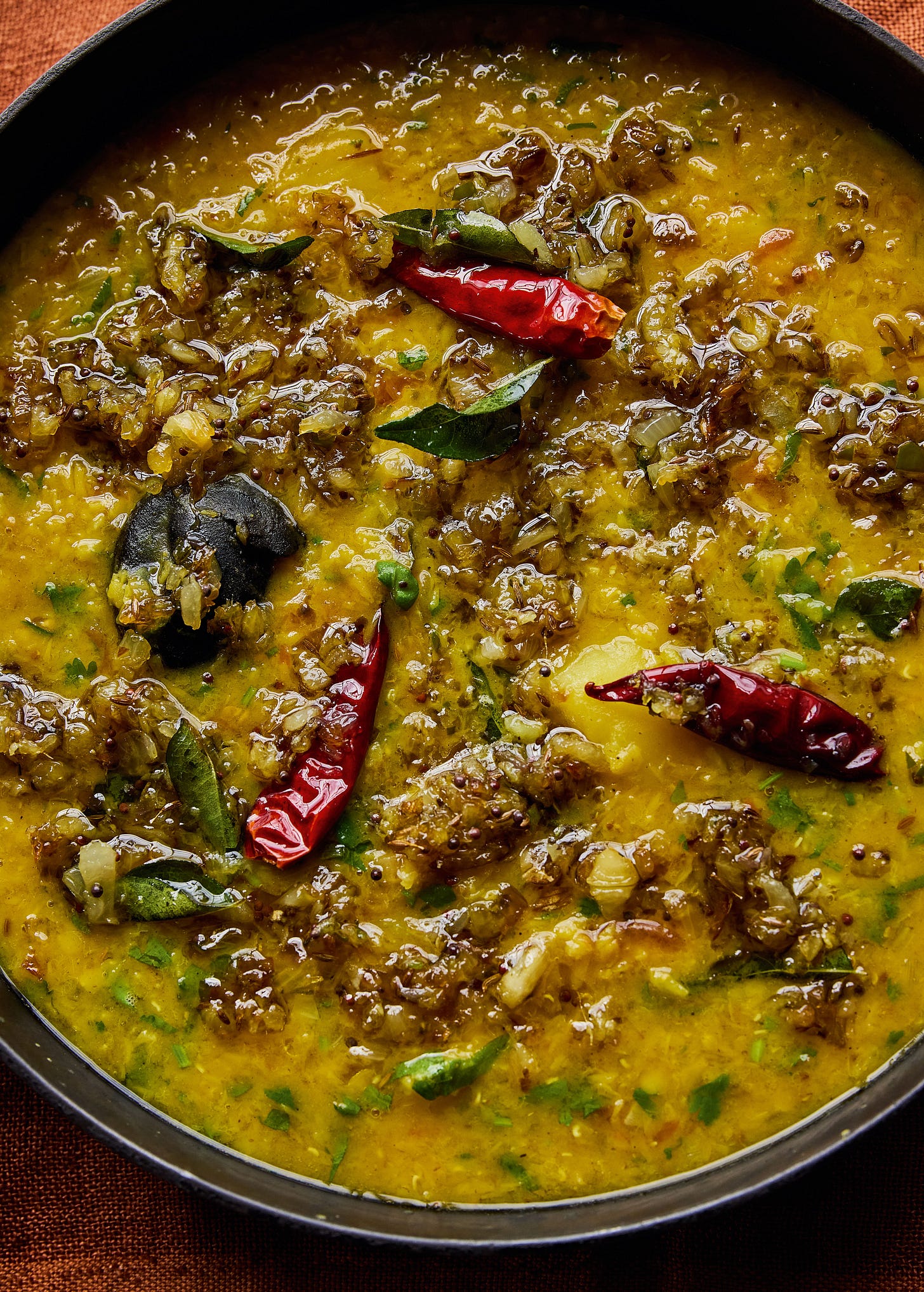One of my favorite cookbooks of 2025 so far
My conversation with Noor Murad about her experience at the Ottolenghi Test Kitchen and the flavor-packed staples she always has in her pantry.
Some cookbooks are so full of evocative writing that they become treasured bedtime reads. Others take their place immediately in the kitchen, because every dish is calling to you.
Lugma, the new cookbook from
, really does both.I want to cook Noor’s baked mushroom rice with cinnamon, her white bean and lamb stew, her savory “trifle” of crispy pita, minty yogurt, roasted eggplant, and smoked-paprika-spiced pine nuts.
I know her one-pan Salmon Harra (reprinted below), cooked with tomatoes and hot Turkish red pepper paste, then showered with cilantro and toasted walnuts, is going in my frequent-dinner rotation—same with the herby Bahraini Dal.
“Bahrain has really unique flavors,” Noor explains, “because historically it was a seaport—a center of trade—and because it’s a tiny island, its identity was formed by pulling on different cultures. Arabic, Persian, and Indian flavors are kind of intertwined into one.” The book celebrates fresh seafood and bold vegetarian mains, fragrant spiced rice dishes and sweets enriched with the caramel-like flavor of dates.
In this week’s episode, I chat with Noor about her most beloved pantry staples, her marathon-training meals, and a few of the things she learned working in the Ottolenghi Test Kitchen. She shares her favorite way to eat spring asparagus, and a dinner party menu that’ll feed you in the week that follows.
I love how Noor talks about resisting the noise of social media: “I find it extremely loud personally,” she tells me. “Here’s a 15 minute meal! Here’s a 30 minute meal! Just adding a time or a target to food instead of being like, this is a meal that comes from my culture. Let me tell you about this story. It’s okay that it takes a long time; there’s like loads of spices in here. This is deeply rooted in tradition.”
“Yeah,” she says. “The world is crazy and hectic and we all have to pay our bills and get to work. But there’s something to be said about slowing down, I think.”
Want to support the show?
Some of you may have noticed that The Dinner Plan now has an option for paid subscriptions. This is an important way for readers to support my work and make producing the podcast each week possible. (If you’re curious about the costs and time involved, you can read more here.)
But please don’t worry if it’s not in your budget right now.
The Dinner Plan’s free subscribers will still get all the regular content of this newsletter, including recipe links, cookbook favorites, and full recipes like the ones below—plus the episodes of the show.
All that stuff is free—just with the option to chip in if you feel like you’re getting something of value from this work.
Starting May 8, about two weeks from now, the weekly cookbook giveaways will become a thank you to those monthly or annual paid subscribers. I’m so grateful for all of your support. Paid subscribers also get access to a little preview of upcoming episode guests in the chat—and you can request your favorite authors, too!
Not ready to commit? You can still help this project by hitting ‘follow’ on the podcast wherever you listen, or making a purchase through the affiliate links in this newsletter or this epic list of guest-recommended cookbooks on Bookshop.
Hitting that ❤️ button at the bottom of this newsletter helps other readers find it—thank you!
Win a copy of Lugma
It’s early in the year to start pronouncing favorites, but Lugma is really something special.
Here’s how to enter to win a copy.
Make sure you’re subscribed to The Dinner Plan. (Free subscribers can enter this one!)
Click the heart icon at the top or bottom of this newsletter.
Leave a comment below.
Book giveaway winner will be alerted by DM and email—be sure to check your messages! U.S. and Canada addresses only, 18+, no purchase necessary. Giveaway not sponsored or administered by Substack. Ends Thursday, May 1, 2025.
Noor mentioned:
Katja Tausig’s Baked Feta and Dill Frittata (Ottolenghi.co.uk)
Noor’s Cod With Brown Butter and Pine Nuts (NYT Cooking, gift link—you can also make this with cauliflower!)
Anissa Helou’s Feast: Food of the Islamic World (Bookshop here)
Najmieh Batmangli’s Food of Life (Bookshop here)
Noor’s Tomato, Potato, and Saffron Rice (reprinted from Lugma in The Guardian)
Falling Out of Love With Food (from Noor’s Substack, NoorishbyNoor)
Find Noor on Instagram; Scribehound Food
Maggie mentioned:
Zaynab Issa’s Chicken Jalfrezi (NYT Cooking, gift link)
Najmieh Batmangli’s Celery Khoresh (Epicurious)
Hetty McKinnon on The Dinner Plan
Amiel Stanek, “The Best Meal Prep is a Sunday Dinner Party” (Bon Appétit)
Asparagus trick from America’s Test Kitchen (TikTok)
A MESSAGE FROM OUR SPONSOR
Cookware sets from Goldilocks have been named a best value pick by Wirecutter and America’s Test Kitchen. Goldilocks tri-ply stainless steel cookware delivers top-tier performance at a remarkable price. Head to cookgoldilocks.com to upgrade your kitchen without breaking the bank.
Salmon Harra
Excerpted with permission from Lugma: Abundant Dishes and Stories from My Middle East by Noor Murad, published by Quadrille, 2025.
Samaka harra, which literally translates as ‘spicy fish’, is typically eaten in coastal towns through the Levant (Syria, Lebanon and Palestine). I first had it in the Syrian port city of Latakia, and was blown away by how tasty it was, despite its simplicity. The secret, I was told, was in the sea bream caught fresh that morning from the Mediterranean. ‘You can’t replicate it,’ the waiter told me, and he was right: nothing will ever taste as good as that from its home origin. I’ve made a few changes here, namely with the fish used, but the essence is in the hot pepper paste, which you can find in most Turkish and Middle Eastern grocery stores and online.
Serves 4
8 garlic cloves
2 Tbsp olive oil, plus 1 tsp extra for the herbs
1 tsp cumin seeds, roughly crushed using a pestle and mortar
1 tsp coriander seeds, roughly crushed using a pestle and mortar
2½ Tbsp hot red pepper paste, biber salçasi
1 Tbsp tomato purée (paste)
¾ tsp sugar
½ lemon, sliced into 4 x 0.5cm (¼ in) rounds, pipes removed
½ small onion, thinly sliced into half-moons (75g/2½ oz)
4 unskinned salmon fillets, or trout fillets if you prefer
2 Tbsp coriander (cilantro), leaves and soft stems picked
2 Tbsp parsley, leaves and soft stems picked
15g (½ oz) walnuts, well toasted and roughly chopped
Fine sea salt and freshly ground black pepper
Preheat the oven to 200°C fan/220°C/425°F/Gas mark 7.
Roughly crush the garlic into pieces using a pestle and mortar (you don’t want the cloves whole but you don’t want them puréed either). Heat the oil in a medium ovenproof sauté pan over a medium-high heat. Fry the garlic for 30–60 seconds, stirring occasionally, until fragrant and lightly coloured. Add the cumin and the coriander seeds and both pastes and cook for another 2 minutes, stirring all the while, until slightly darkened. Pour in 320ml (11fl oz) of water and season with the sugar, ¼ teaspoon salt and a generous grind of pepper.
Bring to the boil and simmer for about 5 minutes, for the flavours to infuse (it will still be a bit loose). Chop each lemon round into four pieces, then stir these and the onion slices into the sauce. Remove from the heat.
Pat dry, then season the salmon all over with ½ teaspoon of salt and a good grind of pepper. Lower the fillets into the sauce, skin-side down, and use a spoon to scoop up the sauce and solids to coat the salmon. Transfer to the oven and bake for 8–10 minutes, or until cooked through (add only a couple more minutes if you prefer your salmon more well done, or if the fillets are particularly large).
Add the fresh cilantro and parsley to a bowl and toss with the extra teaspoon of oil.
When ready, gently transfer the salmon and all of the sauce to a large platter and top with the herbs and the walnuts.
Bahraini Dal
Excerpted with permission from Lugma: Abundant Dishes and Stories from My Middle East by Noor Murad, published by Quadrille, 2025.
Dal is one of the first things that I learnt to make when I started getting into cooking as a teenager. It’s also the one dish I never tired of throughout my university years, when I needed something cheap, quick, nourishing and relatively easy. It’s the dish that has graced every new home I’ve lived in, every new country, every new walk of life. It’s my ‘big feelings and little feelings’ dish, the one thing I’ll turn to when I’m not really sure where to turn at all. That said, I was a bit hesitant about putting a dal recipe in the book, considering how many already exist in the recipe sphere, but it’s such a staple in any Bahraini household. I always serve this with buttery white rice, but you can opt for naan bread or just have it as is with a spoon. I encourage you to play around with this recipe until you get it just how you like it – with more chilli for example or bulked out with a few handfuls of spinach or other vegetables that might need using up.
Serves 6
300g (10½ oz) red split lentils, picked over for any stones, washed and drained very well
1 dried lime, black or regular, pierced a couple times with a sharp knife
2 large plum tomatoes (250g/9 oz)
1 chicken or veggie stock (bouillon) cube
½ red onion, finely chopped
250g (9 oz) floury potatoes such as Maris Piper (about 1–2), peeled and cut into 3–4cm (about 1½ in) chunks
1 tsp cumin seeds, toasted and very finely crushed using a pestle and mortar
2 tsp coriander seeds, toasted and very finely crushed using a pestle and mortar
¾ tsp garam masala
1 tsp ground turmeric 3 tbsp lime juice
20g (¾ oz) coriander (cilantro) leaves, roughly chopped
Fine sea salt and freshly ground black pepper
For the onion topping:
150ml (5 fl oz) olive oil
2 onions, finely chopped
30g (1 oz) fresh ginger, peeled and finely grated
5 garlic cloves, finely grated
1 green chilli, finely chopped, seeds and all
4 dried mild red chillies
20 fresh curry leaves (from 2 stems)
1½ tsp black mustard seeds
1 tsp cumin seeds
Add the lentils, dried lime and 1.6 litres (54fl oz) of water to a large, lidded saucepan over a medium-high heat. Bring to the boil, skimming any scum from the surface, and cook for 15 minutes with the lid off, or until the lentils are quite soft.
Meanwhile, use a small, sharp knife to remove the core from the tomatoes and score the opposite end with an ‘X’. Place in a medium heatproof bowl and pour over enough boiling water to cover. Leave for just 2–3 minutes, then drain off the water and peel and discard the skins. Roughly chop the tomatoes into 2cm (¾ in) pieces.
When the lentils are ready, add the tomatoes, stock cube, red onion, potatoes, spices, 1¼ teaspoons of salt and a generous grind of pepper. Cover with the lid, turn down the heat to medium and cook for 15–18 minutes, stirring a couple of times throughout, or until the potatoes are nice and soft. Take off the heat and stir in the lime juice and fresh coriander.
Towards the last 10 minutes of cooking, make the topping by heating the oil in a medium sauté pan over a medium- high heat. Add the onions and fry for 10–12 minutes, stirring occasionally, until nicely golden. Stir in the ginger, garlic and green chilli and cook for 2 minutes more, stirring often, until fragrant. Lastly add the dried chillies, curry leaves, mustard
and cumin seeds and fry for 1½ minutes more, stirring often, or until the leaves start to turn shiny and translucent and the onions are deeply brown. Immediately pour this into the finished dal, stirring to incorporate.
At this point, feel free to add a splash more water if you prefer a thinner dal. Serve warm.









I'm obsessed with this cover! And everything inside it too.
Lovely interview. I loved what she said about making a meal that has a story--that may take time, but is rooted in tradition. Can't wait to read the cookbook (and cook from it!)